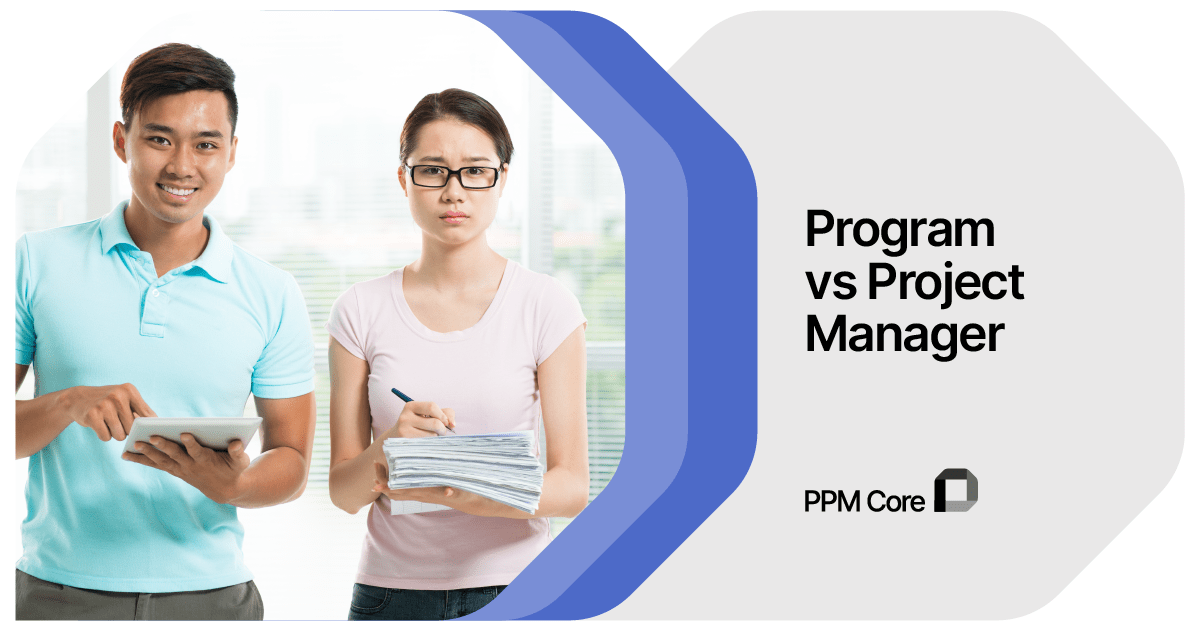Program vs Project Manager – What Are the Differences
What are the difference between a program vs project manager and how do these terms fall and resonate all together within the project management realm? This article will try to provide answer to these questions.
We frequently hear the words projects, program and portfolio in project discussions. These are common jargons in this profession and have specific meanings and applications.
Let us first try to understand each of these terms and then we will try to discuss how these terms are interlinked with each other.
Projects, Programs and Project Portfolios
In simple words, project can be defined as a time bound endeavor to create a unique product, service or results. A project must have a beginning and an end. Projects cannot lasts for infinite amount of times unlike operations which is repetitive and does not necessarily ends.
Program, on the other hand, is simply a group of similar projects. Most often, we do club similar projects into a program for easy manageability. Program helps to manage similar projects in a co-ordination way so that maximum benefit can be achieved and interdependencies can be managed easily.
Figure 1: Programs help to gain efficiency by adding similar projects into a group
Portfolio lies at the top of the pyramid and is linked with company strategy and vision. A portfolio can contain multiple programs, individual projects and even operations. Portfolio looks things from the top and tries to co-ordinate efforts of projects, programs and operations so that company can achieve its goals and objectives.
Figure 2: Portfolio is above the program level and can have operations within its realm
To learn more about the 3Ps you can read the project vs program vs portfolio article on the PPM Core blog.
How are they all linked together?
Project, program, portfolio all are components of an organization’s value delivery system and helps an organization to achieve its mission and vision.
All components create a system that is highly interconnected. We can’t think of an organization where standalone project, program or portfolio can create value. It’s an amalgam where participation of all components are necessary and each component has defined roles to play in providing benefit to the organization
Among all the components, projects and operations are the most visible initiatives that drive company goals. These are the execution level, bottom line fighters. Projects and operations focuses on the lower level parts of a company’s strategy. These are the small droplets that ultimately create the big picture.
Programs work at a higher level and helps to gain benefit by managing similar projects more efficiently. Programs are very important and proven vital in implementing strategic initiatives. Only similar projects are grouped together in a program so that benefit can be obtained through common sources of support, technology, functions or stakeholders. If there is no such benefits, there is no means of adding a project into a program.
Managing interdependencies among the projects within a program is a major responsibility of a program. Programs are typically initiated before associated projects can begin. Once the program structure is formulated, projects are launched. Programs also helps better decision making where conflicts or confusion arises within associated projects.
A portfolio always depicts the big picture and closely related with company’s vision or strategy. Portfolio exists to achieve a company’s one or more strategic goals. An organization can have one or more portfolios where each portfolio is linked with specific strategic objectives. If a portfolio does not represent an organization’s strategy, the organization should reasonably question about the job undertaken.
Portfolio is the representation of an organization’s intent, vision and direction. Components into a portfolio can be programs, projects, sub-portfolios or operations. It’s a centralized way to coordinate lots of initiatives towards a successful end.
Portfolio management helps to balance conflicting demands within portfolio elements. Portfolio often manages the overall business direction of a company. Top managements are connected with portfolios and senior executives constantly look at portfolios to have a glimpse of the company’s current performance and overall status. Portfolio drives the business of a company and is place where game plans are made and executions are overseen.
Project Manager vs Program Manager
A project is managed by the project manager who manages the project team to meet project objectives. Project managers monitor and control the project works to ensure successful completion and handover of a project with defined quality, compliance and customer satisfaction.
Project managers are more like of a working level managers who work side by side with the project team to deliver quality products. Project managers need to have knowledge to manage the project team.

Do you find this article interesting?
Subscribe to our Newsletter for updates on the latest blog articles.
Also, they must have knowledge on basic project domains like quality management, risk management, schedule management, cost management, communication management, stakeholder management etc.
In addition, project managers must be aware of how the project is connected with strategy and goal. Projects and operations deliver measurable outputs. Thus projects’ success is very important for any organization and so the project manager role is also vital.
Programs are managed by program managers and the main responsibility of a program manager is to manage and co-ordinate the interdependencies between relevant projects. Normally two or more project manager report to a program manager and the program manager can make a plan to optimize the benefit though some common grounds.
Program managers works under the portfolio managers or PMO leads. They require to have technical project management knowledge and deep understanding about organizational processes and resources so that they can work as a coordinator for multiple projects.
| Program Manager | Project Manager |
| More employees under their watch and more responsibilities as they supervise strategic execution of smaller projects on long term basis | In charge for less employees. Supervise smaller endeavors that meet program objectives |
| Dynamic and flexibility in work as program goals can change over time | Project lead into single outcome, completion |
| Certification differences – PgMP | Certification differences – PMP |
| Create and monitor execution of strategies and procedures for individual projects | Run projects using predefined strategies and procedures |
| Strategic mindset | Operating mindset |
Project Portfolio Manager
Portfolio managers stands at the top and observe the overall performance of the portfolio. They often take important strategic decisions to align company goals with market needs and external business environments.
Portfolio managers can intervene into programs, projects or operational activities to ensure right execution and to adjust directions. They are also responsible to ensure all organizational level supports like funding and process alignment etc. to ensure a portfolio can hit its target.
Portfolio managers are the stewards of the ship and has the responsibility to navigate the business through proper execution of portfolio plans.
If we analyze the responsibilities, we can easily identify that, portfolio manager should be a visionary leader and s/he needs to navigate overall efforts from the top. Portfolio manager focuses on the big picture and needs to have necessary knowledge and leadership skills to support big initiatives.
Project, program, portfolio all work together to deliver value to a company
Ultimate focus of projects, programs and portfolio is to deliver superior value to the organization and its stakeholder.
Here, value can be a benefit or a worth of somethings. Value can have tangible or intangible elements. Monetary gains, shareholder satisfaction, and utility can be tangible value. On the other hand, company reputation, brand value, patents, and trademarks can be intangible value.
Figure 3: Value delivery system of an organization
How projects, programs, portfolio and operation will interact with each other, it often depends on the organizational design and governance framework.
An organization can make necessary changes in the standard frameworks to meet organization’s specific needs. Thus we may see a portfolio where operations never included.
Also, there might be projects that directly connected with portfolios without any programs in between.
It all depends on nature of the industry, organizational culture, management perception and many other factors. But the bottom line is, all the same. Project, program, portfolio are means of achieving organizational targets thorough a coordinated and structured way.
When organizations get bigger, there is no simple way to manage things rather than dividing big chunks into smaller components and making a workflow that goes from top to bottom. Project, program, portfolio is one of the simple means to achieve this benefit, and all three can be easily managed by using software tool such as PPM Core.
PPM Core – Project, Program and Project Portfolio Management Software
PPM Core is an all-around platform that helps project managers to stay on top of their projects and efficiently manage all projects and project operations. At the same time, PPM Core features simple to use project program and portfolio management module that answers the different needs of both program and portfolio managers, thus fully supporting them in their daily job responsibilities.
What is unique about the PPM Core platform is it’s versatility to satisfy the needs of all the different project participants and roles, including the team members who can easily get access to the schedule and view their immediate assignments.
PPM Core brings together teams, and all the project information, or schedules created with different tools and integrates them in a way that all project participants can quickly access and use the needed project data in a way that satisfies the need of each different project role. The platform is consisted of several modules including:
- Universal Project Viewer – a core module of the application that provides view-only access to schedule details and data about different projects, no matter what software has been used to create the project plan, to all relevant parties and stakeholders involved in the project. Alongside the Universal Project Viewer, comes a project reporting feature catered for the project manager, as well as program and project portfolio managers, that provides the needed support for efficiently managing the individual project’s execution
- Project Portfolio Management – an integral module that supports the PMO and program managers in creating, optimizing and managing project portfolios
To learn more about the product, you book a personal online demo presentation with a member of team today!




